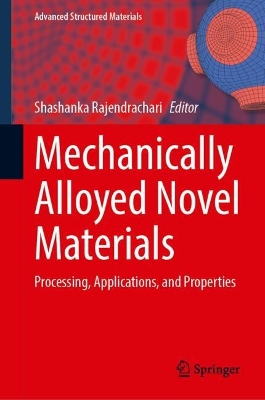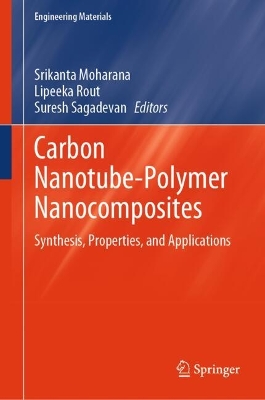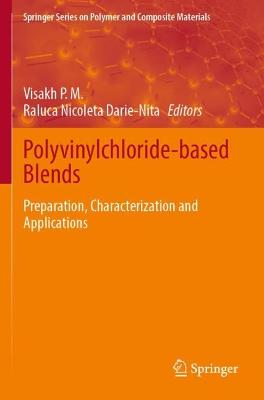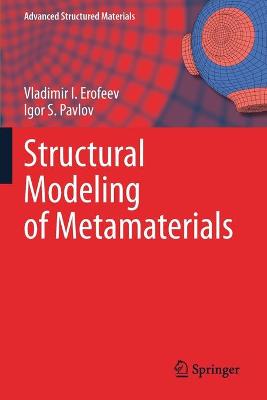Multiscaled PVA Bionanocomposite Films
 portes grátis
portes grátis
Multiscaled PVA Bionanocomposite Films
Characterisation and Nanoscale Modelling
Mousa, Mohanad; Dong, Yu
Springer Verlag, Singapore
12/2021
179
Mole
Inglês
9789811587733
15 a 20 dias
302
Descrição não disponível.
Chapter 1. Introduction
1.1.Biopolymers
1.1.1 Poly(vinyl alcohol) (PVA)
1.2. Nanofillers for bionanocomposites
1.2.1. Layered silicates
1.2.2 Halloysite nanotubes(HNTs)
1.2.3 Bamboo charcoals (BCs)
1.2.4 Other popular nanofillers
1.3. Processing of bionanocomposites
1.4. Properties and characterisation of bionanocomposites
1.4.1 Morphological structures
1.4.2 Mechanical properties
1.4.3 Nanomechanical properties
1.4.4. Thermal properties
1.5. Modelling approaches
1.6. Application of bionanocomposites
1.6.1. Electronic and sensor applications
1.6.2 Medical applications
1.6.3 Packaging applications
Chapter 2 Materials, methodology and characterisation techniques
2.1. Materials
2.1.1. Polyvinyl alcohol (PVA)
2.1.2. Nanoparticles
2.1.2.1. Bamboo charcoals (BCs)
2.1.2.2 Clay nanoparticles
2.1.2.3 Halloysite nanotubes (HNTs)
2.2. Fabrication of PVA bionanocomposite films
2.3. Characterisation techniques
2.3.1. X-ray diffraction (XRD) analysis
2.3.2. Fourier transform infrared (FTIR) analysis
2.3.3. Scanning electron microscopy (SEM)
2.3.4. Differential scanning calorimetry (DSC)
2.3.5. Thermal gravimetric analysis (TGA)
2.3.6. Mechanical testing
2.3.7. Nanomechanical characterisation
Chapter 3 PVA/BC bionancomposite films with particle size effect
3.1. BC particle analysis and characterisation
3.1.1. BC composition and surface area
3.1.2. Particle size and elastic modulus
3.1.3. FTIR and XRD analyses
3.2. Characterisation and properties of PVA/BC bionanocomposites
3.2.1. FTIR and XRD spectra
3.2.2. Mechanical properties
3.2.3. Fracture morphology
3.2.4. Thermal properties
3.2.5. Morphological structures and nanomechanical properties
Chapter 4 PVA bionanocomposite films with different particle shapes and structures
4.1. FTIR spectra
4.2. XRD patterns
4.3. Morphological structures and nanomechanical properties
4.4. Mechanical properties
4.5. Fracture morphology
4.6. Thermal properties
Chapter 5 3D interphase of PVA bionanocomposite films
5.1. Interphase properties and features
5.2. Modelling approach
5.3. Interphase modulus
5.4. Interphase dimensions
5.5. Modulus-gradient effect
5.6. 3D interphase modulus and dimensions
5.7. Particle debonding
Chapter 6 Micromechanical modelling of PVA bionanocomposite films
6.1. Modelling theory
6.1.1. Micromechanical models based on nominal and effective volume
fractions
6.1.2. Micromechanical models based on volume fractions of nanofillers and
interphase
6.1.3. Interphase volume fraction
6.2. Prediction of elastic moduli of PVA bionancomposites
References
Appendices
1.1.Biopolymers
1.1.1 Poly(vinyl alcohol) (PVA)
1.2. Nanofillers for bionanocomposites
1.2.1. Layered silicates
1.2.2 Halloysite nanotubes(HNTs)
1.2.3 Bamboo charcoals (BCs)
1.2.4 Other popular nanofillers
1.3. Processing of bionanocomposites
1.4. Properties and characterisation of bionanocomposites
1.4.1 Morphological structures
1.4.2 Mechanical properties
1.4.3 Nanomechanical properties
1.4.4. Thermal properties
1.5. Modelling approaches
1.6. Application of bionanocomposites
1.6.1. Electronic and sensor applications
1.6.2 Medical applications
1.6.3 Packaging applications
Chapter 2 Materials, methodology and characterisation techniques
2.1. Materials
2.1.1. Polyvinyl alcohol (PVA)
2.1.2. Nanoparticles
2.1.2.1. Bamboo charcoals (BCs)
2.1.2.2 Clay nanoparticles
2.1.2.3 Halloysite nanotubes (HNTs)
2.2. Fabrication of PVA bionanocomposite films
2.3. Characterisation techniques
2.3.1. X-ray diffraction (XRD) analysis
2.3.2. Fourier transform infrared (FTIR) analysis
2.3.3. Scanning electron microscopy (SEM)
2.3.4. Differential scanning calorimetry (DSC)
2.3.5. Thermal gravimetric analysis (TGA)
2.3.6. Mechanical testing
2.3.7. Nanomechanical characterisation
Chapter 3 PVA/BC bionancomposite films with particle size effect
3.1. BC particle analysis and characterisation
3.1.1. BC composition and surface area
3.1.2. Particle size and elastic modulus
3.1.3. FTIR and XRD analyses
3.2. Characterisation and properties of PVA/BC bionanocomposites
3.2.1. FTIR and XRD spectra
3.2.2. Mechanical properties
3.2.3. Fracture morphology
3.2.4. Thermal properties
3.2.5. Morphological structures and nanomechanical properties
Chapter 4 PVA bionanocomposite films with different particle shapes and structures
4.1. FTIR spectra
4.2. XRD patterns
4.3. Morphological structures and nanomechanical properties
4.4. Mechanical properties
4.5. Fracture morphology
4.6. Thermal properties
Chapter 5 3D interphase of PVA bionanocomposite films
5.1. Interphase properties and features
5.2. Modelling approach
5.3. Interphase modulus
5.4. Interphase dimensions
5.5. Modulus-gradient effect
5.6. 3D interphase modulus and dimensions
5.7. Particle debonding
Chapter 6 Micromechanical modelling of PVA bionanocomposite films
6.1. Modelling theory
6.1.1. Micromechanical models based on nominal and effective volume
fractions
6.1.2. Micromechanical models based on volume fractions of nanofillers and
interphase
6.1.3. Interphase volume fraction
6.2. Prediction of elastic moduli of PVA bionancomposites
References
Appendices
Este título pertence ao(s) assunto(s) indicados(s). Para ver outros títulos clique no assunto desejado.
Biopolymers;Layered silicates;Halloysite nanotubes(HNTs);Bamboo charcoals (BCs);Clay nanoparticles;Thermal gravimetric analysis (TGA);Differential scanning calorimetry (DSC);Nanomechanical characterisation;Fracture morphology;Effective volume fractions
Chapter 1. Introduction
1.1.Biopolymers
1.1.1 Poly(vinyl alcohol) (PVA)
1.2. Nanofillers for bionanocomposites
1.2.1. Layered silicates
1.2.2 Halloysite nanotubes(HNTs)
1.2.3 Bamboo charcoals (BCs)
1.2.4 Other popular nanofillers
1.3. Processing of bionanocomposites
1.4. Properties and characterisation of bionanocomposites
1.4.1 Morphological structures
1.4.2 Mechanical properties
1.4.3 Nanomechanical properties
1.4.4. Thermal properties
1.5. Modelling approaches
1.6. Application of bionanocomposites
1.6.1. Electronic and sensor applications
1.6.2 Medical applications
1.6.3 Packaging applications
Chapter 2 Materials, methodology and characterisation techniques
2.1. Materials
2.1.1. Polyvinyl alcohol (PVA)
2.1.2. Nanoparticles
2.1.2.1. Bamboo charcoals (BCs)
2.1.2.2 Clay nanoparticles
2.1.2.3 Halloysite nanotubes (HNTs)
2.2. Fabrication of PVA bionanocomposite films
2.3. Characterisation techniques
2.3.1. X-ray diffraction (XRD) analysis
2.3.2. Fourier transform infrared (FTIR) analysis
2.3.3. Scanning electron microscopy (SEM)
2.3.4. Differential scanning calorimetry (DSC)
2.3.5. Thermal gravimetric analysis (TGA)
2.3.6. Mechanical testing
2.3.7. Nanomechanical characterisation
Chapter 3 PVA/BC bionancomposite films with particle size effect
3.1. BC particle analysis and characterisation
3.1.1. BC composition and surface area
3.1.2. Particle size and elastic modulus
3.1.3. FTIR and XRD analyses
3.2. Characterisation and properties of PVA/BC bionanocomposites
3.2.1. FTIR and XRD spectra
3.2.2. Mechanical properties
3.2.3. Fracture morphology
3.2.4. Thermal properties
3.2.5. Morphological structures and nanomechanical properties
Chapter 4 PVA bionanocomposite films with different particle shapes and structures
4.1. FTIR spectra
4.2. XRD patterns
4.3. Morphological structures and nanomechanical properties
4.4. Mechanical properties
4.5. Fracture morphology
4.6. Thermal properties
Chapter 5 3D interphase of PVA bionanocomposite films
5.1. Interphase properties and features
5.2. Modelling approach
5.3. Interphase modulus
5.4. Interphase dimensions
5.5. Modulus-gradient effect
5.6. 3D interphase modulus and dimensions
5.7. Particle debonding
Chapter 6 Micromechanical modelling of PVA bionanocomposite films
6.1. Modelling theory
6.1.1. Micromechanical models based on nominal and effective volume
fractions
6.1.2. Micromechanical models based on volume fractions of nanofillers and
interphase
6.1.3. Interphase volume fraction
6.2. Prediction of elastic moduli of PVA bionancomposites
References
Appendices
1.1.Biopolymers
1.1.1 Poly(vinyl alcohol) (PVA)
1.2. Nanofillers for bionanocomposites
1.2.1. Layered silicates
1.2.2 Halloysite nanotubes(HNTs)
1.2.3 Bamboo charcoals (BCs)
1.2.4 Other popular nanofillers
1.3. Processing of bionanocomposites
1.4. Properties and characterisation of bionanocomposites
1.4.1 Morphological structures
1.4.2 Mechanical properties
1.4.3 Nanomechanical properties
1.4.4. Thermal properties
1.5. Modelling approaches
1.6. Application of bionanocomposites
1.6.1. Electronic and sensor applications
1.6.2 Medical applications
1.6.3 Packaging applications
Chapter 2 Materials, methodology and characterisation techniques
2.1. Materials
2.1.1. Polyvinyl alcohol (PVA)
2.1.2. Nanoparticles
2.1.2.1. Bamboo charcoals (BCs)
2.1.2.2 Clay nanoparticles
2.1.2.3 Halloysite nanotubes (HNTs)
2.2. Fabrication of PVA bionanocomposite films
2.3. Characterisation techniques
2.3.1. X-ray diffraction (XRD) analysis
2.3.2. Fourier transform infrared (FTIR) analysis
2.3.3. Scanning electron microscopy (SEM)
2.3.4. Differential scanning calorimetry (DSC)
2.3.5. Thermal gravimetric analysis (TGA)
2.3.6. Mechanical testing
2.3.7. Nanomechanical characterisation
Chapter 3 PVA/BC bionancomposite films with particle size effect
3.1. BC particle analysis and characterisation
3.1.1. BC composition and surface area
3.1.2. Particle size and elastic modulus
3.1.3. FTIR and XRD analyses
3.2. Characterisation and properties of PVA/BC bionanocomposites
3.2.1. FTIR and XRD spectra
3.2.2. Mechanical properties
3.2.3. Fracture morphology
3.2.4. Thermal properties
3.2.5. Morphological structures and nanomechanical properties
Chapter 4 PVA bionanocomposite films with different particle shapes and structures
4.1. FTIR spectra
4.2. XRD patterns
4.3. Morphological structures and nanomechanical properties
4.4. Mechanical properties
4.5. Fracture morphology
4.6. Thermal properties
Chapter 5 3D interphase of PVA bionanocomposite films
5.1. Interphase properties and features
5.2. Modelling approach
5.3. Interphase modulus
5.4. Interphase dimensions
5.5. Modulus-gradient effect
5.6. 3D interphase modulus and dimensions
5.7. Particle debonding
Chapter 6 Micromechanical modelling of PVA bionanocomposite films
6.1. Modelling theory
6.1.1. Micromechanical models based on nominal and effective volume
fractions
6.1.2. Micromechanical models based on volume fractions of nanofillers and
interphase
6.1.3. Interphase volume fraction
6.2. Prediction of elastic moduli of PVA bionancomposites
References
Appendices
Este título pertence ao(s) assunto(s) indicados(s). Para ver outros títulos clique no assunto desejado.







